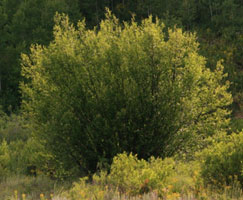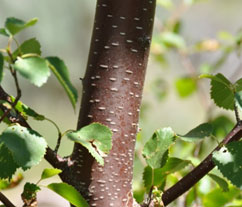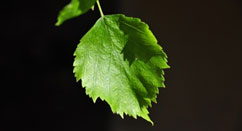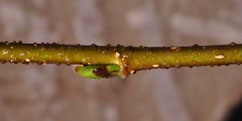Betula occidentalis in the Landscape




Larry A. Rupp, Utah State University
Scientfic Name: Betula occidentalisCommon Name: Water birch
Description: Commonly found as a multi-stemmed small tree or large shrub with copper-colored bark and prominent lenticels. Leaves are small (2-5 cm long) with toothed margins. Stems are somewhat sticky to the touch and covered with resinous glands. The crowns of older plants are often very dense with multiple shoots of various ages. The crown is generally rounded to oblong in form and can be up to 30 feet in height (with some specimens being much taller), but is more commonly 15-20 feet tall. Fall color is commonly yellow, but can range to a red-orange.
Native Habitat: Restricted to riparian zones throughout the western continental United States and western Canada and into Alaska. In the intermountain area it is commonly found along mountain streams bridging mountains with desert regions.
Cultural Requirement
Soil: Generally found in areas with coarse, alkaline soils that are moist to wet.
Moisture Tolerance: While a native plant, it is not drought tolerant, but can tolerate periodic flooding. Moisture stress results in yellowing of leaves followed by abscission.
Sun/Shade/Preference: Tolerates full sun or partial shade
Transplanting: Easy to transplant
Propagation: Easily propagated by seed. Does not require stratification, but is enhanced by it. Care must be taken in urban areas to insure seedling propagated plants are not inadvertent hybrids with other birch species.
Maintenance (pruning, fertilization, deadheading, division, irrigation, etc): In general water birch is a low maintenance plant. Minimal pruning is required, and then only to remove crossing or crowded branches. Pruning should consist largely of careful removal of overgrown or poorly placed stems at the base. Unlike many native plants, over-irrigation should not be a problem. It is not a drought tolerant plant and the appearance of yellow leaves in mid-summer is a good indicator of water stress.
Insect, disease, or other problems: Unlike eastern or European birches, western river birch is resistant to the bronze birch borer and the subsequent stem damage it causes. Susceptibility to birch leaf miner seems to vary with individual plants, with some being entirely free of this pest while others are severely hampered by it.
Landscape Value
Use in the Landscape: Can be a very effective hedge along border areas where the wideness of the tree is not a problem. A good choice in any area plagued by moist soils or partial shade. Can also be used as a specimen plant.
Foliage: Alternate leaves that are usually 1-2 inches long and green to bright green in color. Leaves are deciduous with yellow being the common fall color.
Fruit: Seeds are very small and consist of single-seeded nutlets in samaras. They are often seen scattered on winter snows following heavy winds.
Form: Multiple stems with rounded to oval shape overall
Texture: Medium to fine
Ultimate Size: Usually 30 feet or less
Rate of Growth: Fast initially and then slowing with age
Suggested Plant Partners: redstem dogwood, spruce, fir, Douglas hawthorn, chokecherry, skunkbush sumac, serviceberry, and currant.
Availability: Commonly available in nurseries and reclamation stock sources. Since it is seed propagated care must be taken to insure seed source. Hybrids can result in variation in bark color and increased susceptibility to leaf miners.
Cultivars: None
References:
Shaw, N.L., S.B. Monsen, and R. Stevens. 2004. Shrubs of Other Families. In: Monsen, S.B., R. Stevens, and N.L. Shaw., comps. 2004. Restoring western ranges and wildlands. Gen. Tech. Rep. RMRS-GTR-136-vol-2. Fort Collins, CO; USDA For. Serv. Rocky Mtn Res. Station pp. 545-552.
Gucker, C. 2012. Betula occidentalis. In: Fire Effects Information System, [Online]. U.S. Department of Agriculture, Forest Service, Rocky Mountain Research Station, Fire Sciences Laboratory (Producer). Available: http://www.fs.fed.us/database/feis/ [2013, December 27].

